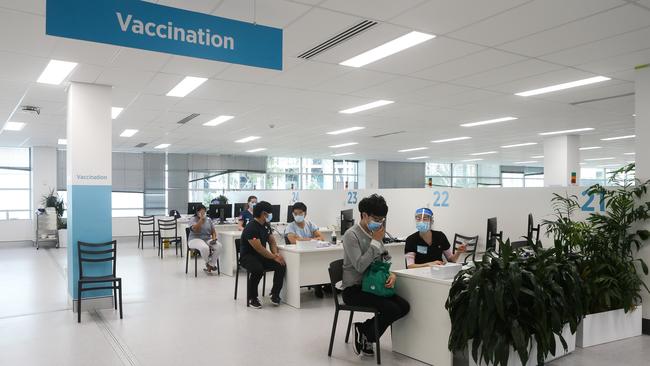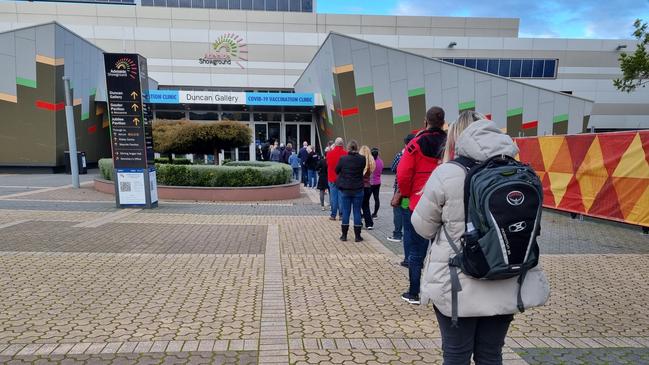‘Begging for more vaccines’: Budget reveals half a billion dollars to continue Covid jabs
The government is spending an eye-watering amount of money to continue the national Covid vaccine program, even as more than one third of the jabs are wasted.
Fed Budget
Don't miss out on the headlines from Fed Budget. Followed categories will be added to My News.
The federal government will spend nearly half a billion dollars to continue the national Covid vaccine program over the next four years, even as booster rates hover below 4 per cent for under-65s.
Days after yet another highly transmissible Covid variant was first detected in Australia, sparking warnings from health officials to stay up-to-date with the latest booster advice, Tuesday night’s federal budget warned that the virus “continues to be a contributor to the burden of disease”.
“[The government] is providing $490 million over four years from 2024-25 (and $107.4 million per year ongoing) to continue the National Covid-19 Vaccine Program,” the budget states.
Despite the large investment, a Health Department spokeswoman said on Thursday that “no Covid-19 vaccine purchases have been funded” through the budget measure.
The Health Department would not reveal the value of vaccine inventories and prepayments represented in the overall portfolio schedule of assets and liabilities.
“Any further breakdown would be commercial-in-confidence,” the spokeswoman said.
She confirmed that as of May 2, 2024, the total Covid vaccine program wastage rate was 37.8 per cent.
“Approximately 80 per cent of vaccine wastage is attributed to expiry of doses across warehouses and vaccine administration sites,” she said.
“Australia’s wastage rate is within the World Health Organisation (WHO) acceptable wastage parameters for multidose vials of 15 per cent and 40 per cent. While all avenues to avoid wastage continue to be explored, it is an inevitable component of any vaccination program.”
PCR testing will also be added to the Medicare Benefits Schedule, which will cost $335.7 million over the next four years, with the government predicting it will be used on 8.9 millon patients.
Just 3.9 per cent (613,300) of Australians aged 18 to 64 have had a booster dose in the last six months, according to figures released by the Health Department last week.
One quarter (606,700) of those aged 65 to 74 have had a booster in the last six months, rising to one in four (752,200) among over-75s.
The latest advice from the Australian Technical Advisory Group on Immunisation (ATAGI) recommends ongoing Covid vaccinations “every six to 12 months” for older adults and adults with severe immune conditions.

For adults aged 75 and over the recommendation is every six months.
For adults aged 65 to 74 and immunocompromised adults aged 18 to 64, ATAGI recommends a dose every 12 months but says they can “consider a dose every six months, based on a risk-benefit assessment”.
All other adults aged 18 to 64, and children aged five to 18 with severe immune conditions, should also “consider” a vaccine every 12 months, according to ATAGI.
Pfizer and Moderna’s updated vaccines targeting the Omicron XBB.1.5 variant are preferred for over-12s, while Pfizer’s version is preferred for children aged five to 11.
Pfizer’s Omicron vaccine for children aged six months to five years has been approved by the Therapeutic Goods Administration (TGA) but is not yet available for use.
It comes after a family of highly transmissible Omicron descendants was recently detected for the first time in NSW and Victoria.
KP.2, which has recently overtaken its parental strain, JN.1, to become dominant in the US, is part of a family scientists have dubbed “FLiRT variants”, after the technical names for their mutations.
It’s not exactly clear how effective the current vaccines are against the latest strains.
“Against JN.1, the vaccine designed around XBB.1.5 does generate some cross-reactive antibodies,” Johns Hopkins immunologist Andy Pekosz said in a Q&A this week.
“Studies have not been yet done with some of these newer variants, but those are likely to be a little less cross-reactive.”
Professor Adrian Esterman, chair of biostatistics and epidemiology at the University of South Australia, told SBS the new FLiRT subvariants were “taking off” but stressed it was “not a major issue” for most adults.
“From the evidence that we know so far, it’s pretty similar to JN.1 in terms of the severity of infection, in terms of the types of symptoms — it’s much of the same,” Prof Esterman said.

“Most adults, really and truly, there’s nothing to worry about. If they’re careful, then they’ll get an updated booster shot if they haven’t had one in the last 12 months.
“If they do get infected, chances are [it will be] just like a nasty flu, and for many people they’ll be no symptoms at all.”
Tuesday’s budget papers, meanwhile, reveal the Covid vaccine injury scheme will cost $4.4 million to administer this financial year, before falling to $1.1 million next year.
The Covid-19 Vaccine Claims Scheme, administered by Services Australia, is being wound up as of September 30, 2024.
Services Australia says as of March 31, 2024, around $20.5 million has been paid out and 286 claims approved.
A further 2070 claims have been rejected and 964 withdrawn.
Vaccine injury advocates have long criticised the scheme as being difficult to navigate and too narrowly tailored towards a handful of recognised adverse reactions associated with AstraZeneca, Pfizer, Moderna and Novavax.
“With the scheme winding up this year, and the fact that most of us still don’t qualify even though the rules have changed slightly, the numbers that have been paid out still represent only a minuscule fraction of all the injured people here in Australia,” said Dr Rado Faletic, co-founder of vaccine injury charity Coverse.
“We estimate over 99 per cent of vaccine-injured Australians have not and cannot be compensated under the current scheme. You could easily add a few more zeros onto that [dollar figure] as to the true liability, but the government doesn’t care.”
The TGA ceased publishing regular Covid vaccine safety reports in November 2023.
As of October 29, 2023, the medicines regulator had received 139,654 adverse event reports from 68.86 million total doses.

Fourteen deaths were found to be related to vaccination; 13 after an AstraZeneca jab and one after Moderna.
AstraZeneca, which was discontinued in Australia in March last year, was withdrawn globally earlier this month after the manufacturer admitted in a UK court that it could cause fatal blood clots and low platelet counts.
Dr Faletic questioned the “massive” investment into continuing the vaccination program.
“I know there are people out there who are begging for more vaccines but most people … when they get Covid, which most people have, they’re like, well what was that all about?” he said.
“I think most people are also smart enough to think that maybe the vaccine did help, but I’ve had Covid now, and despite what pharma says [it’s the best protection].”
As part of its Covid measures, Tuesday’s budget also notes “the government is ensuring continued access to oral antiviral medicines on the Pharmaceutical Benefits Scheme (PBS) for those at risk of serious disease”.
That’s despite serious questions being raised about one of those antivirals, Pfizer’s Paxlovid (nirmatrelvir-ritonavir).
Last month, a study published in The New England Journal of Medicine suggested Paxlovid was virtually indistinguishable from a placebo for those not already at high risk of Covid. The study’s publication nearly two years after the trials was widely criticised.
“Pfizer should be held accountable for suppressing data from this study,” ANU infectious diseases expert Professor Peter Collignon wrote at the time.
“They must have known by July 2022 that their very expensive drug, at $1000 per course, was ineffective. But suppressed the data release. They made extra billions from sales as a result over the last two years and exploiting people’s fears.”
Originally published as ‘Begging for more vaccines’: Budget reveals half a billion dollars to continue Covid jabs





